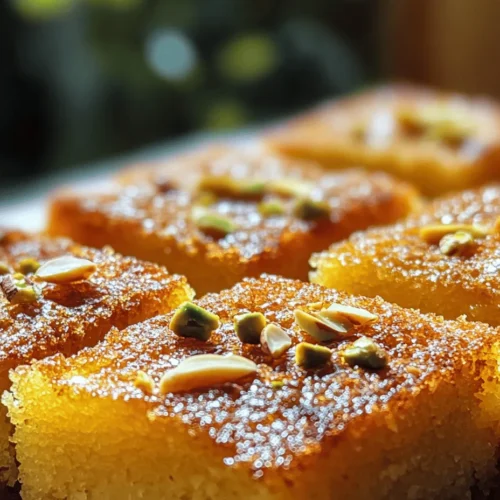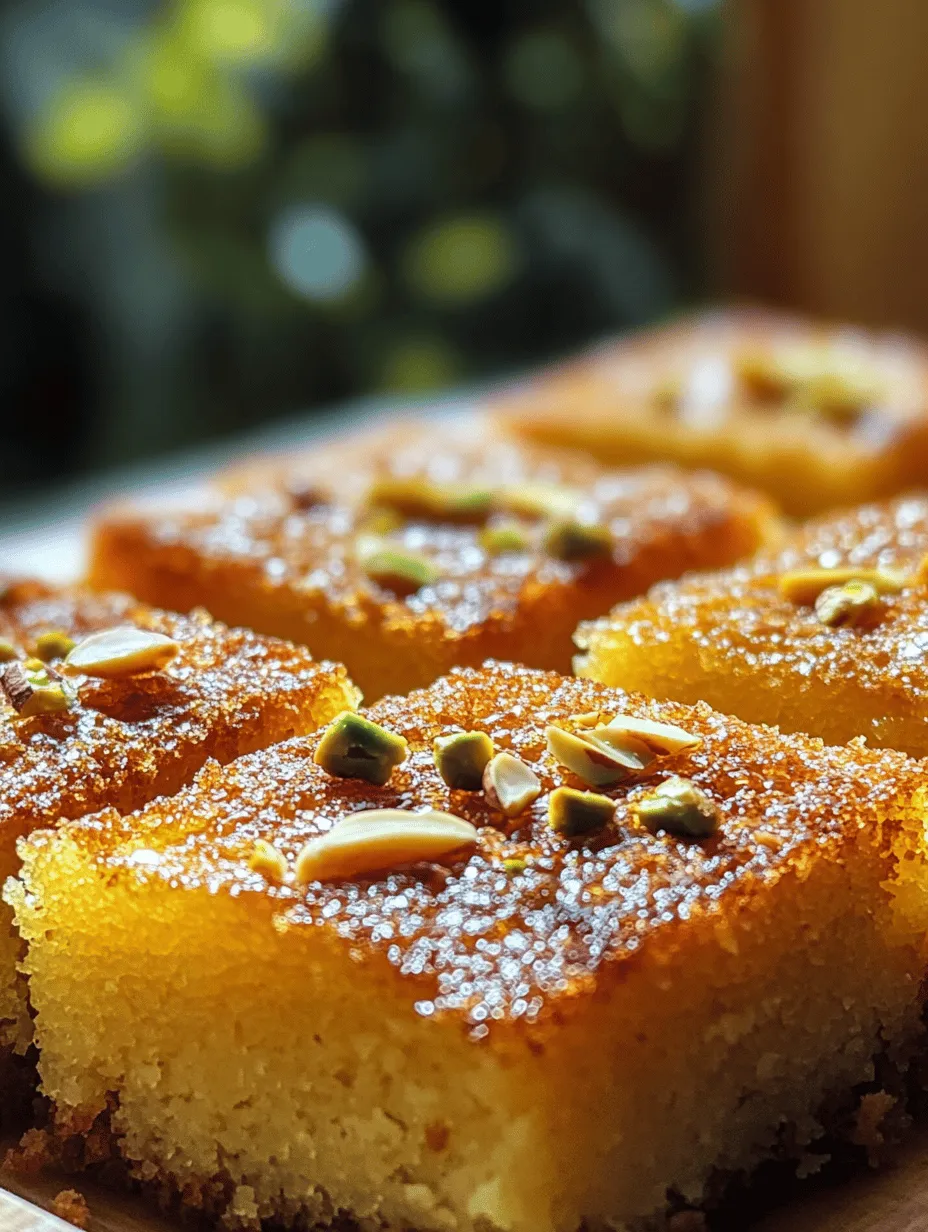Introduction
Revani, also known as Ravani, is a delightful semolina cake that has captured the hearts of dessert lovers across Mediterranean and Middle Eastern regions. This traditional cake is characterized by its unique texture and flavor, making it a staple at gatherings, celebrations, and special occasions. The cake is soaked in a sweet syrup, which adds a lusciousness that complements its lightly spongy structure beautifully.
The cultural significance of Revani extends beyond just being a dessert; it represents hospitality and the joy of sharing food with loved ones. Whether served at a festive occasion or as an everyday treat, Revani evokes a sense of belonging and warmth. Its popularity is a testament to the way it brings people together, transcending borders and cultures.
Moreover, one of the most appealing aspects of Revani is its simplicity of preparation. Even novice bakers can create this delectable cake with ease, making it a perfect choice for anyone looking to impress their guests without the stress of complicated baking techniques. The preparation process is straightforward, allowing you to focus on the joy of serving and enjoying this wonderful dessert.
Understanding Revani Cake
The origins of Revani can be traced back to various cultures, particularly in Greece, Turkey, and the Levant region. While each culture has its own variations and names for the cake, the essence remains the same—a moist, sweet treat made primarily from semolina. In many households, Revani is often prepared to celebrate significant occasions, such as weddings, birthdays, and holidays, symbolizing joy and abundance.
What sets Revani apart from other cakes is its distinct texture. Unlike the lightness of a sponge cake or the richness of a butter cake, Revani offers a unique combination of density and moistness, thanks to the semolina flour. This grainy texture provides a satisfying bite that is both comforting and indulgent. The cake is often infused with flavors like lemon or orange, which enhances its overall appeal and creates a refreshing experience with each bite.
Semolina, a coarsely ground durum wheat, plays a pivotal role in the baking of Revani. This ingredient not only contributes to the cake’s structure but also helps retain moisture, ensuring that the final product is soft and tender. Semolina is known for its ability to absorb liquids, which is crucial when the cake is soaked in syrup after baking. This characteristic allows the cake to become even more flavorful and moist, making every piece a delightful experience.
Ingredients Breakdown
To create the perfect Revani cake, a selection of quality ingredients is essential. Here’s a closer look at each component and its significance:
– Semolina: This is the star ingredient of the cake. Semolina is a type of wheat flour that is coarser than regular flour, lending a unique texture to the cake. It is rich in gluten, which helps provide structure while keeping the cake moist.
– Granulated Sugar: Sugar not only sweetens the cake but also plays a crucial role in its texture. It helps to create a tender crumb and balances the flavors, especially when paired with the tanginess of the syrup.
– Plain Yogurt: Yogurt is an essential ingredient in Revani, contributing both moisture and flavor. It adds a slight tang that complements the sweetness of the cake and enhances its overall taste.
– Vegetable Oil vs. Melted Butter: Both vegetable oil and melted butter can be used in this recipe. Vegetable oil creates a lighter texture and is often preferred for its neutral flavor, while melted butter adds a rich, buttery taste. The choice between the two depends on personal preference and dietary considerations.
– Eggs: Eggs are vital for binding the ingredients together and adding moisture. They also help the cake rise, ensuring a fluffy and light result.
– Baking Powder: This leavening agent is necessary for helping the cake to rise during baking. It reacts with the other ingredients to create air bubbles, giving the cake its light structure.
– Vanilla Extract and Lemon Zest: These flavor enhancers are crucial for elevating the taste of Revani. Vanilla extract adds a warm sweetness, while lemon zest imparts a fresh, zesty note that balances the richness of the cake.
– Syrup Components: The syrup is what truly makes Revani special. Typically made with sugar, water, and flavored with lemon or orange juice, the syrup soaks into the cake after baking, adding moisture and sweetness. The syrup’s consistency is crucial, as it should be thick enough to coat the cake without making it overly soggy.
Preparation Steps Explained
Preparing the Syrup
Before you dive into making the cake itself, it’s essential to prepare the syrup. This step ensures that the syrup has time to cool while the cake bakes, allowing for optimal soaking later. Here’s a step-by-step guide to creating the syrup:
1. Combine Ingredients: In a medium saucepan, combine equal parts sugar and water. For a standard Revani recipe, you might start with 1 cup of sugar and 1 cup of water.
2. Add Flavoring: Depending on your preference, add the juice of half a lemon or a few slices of lemon for a citrusy flavor. This not only enhances the taste but also helps prevent the sugar from crystallizing.
3. Heat the Mixture: Place the saucepan over medium heat and stir until the sugar dissolves completely. Bring the mixture to a gentle boil.
4. Simmer: Once boiling, reduce the heat and let it simmer for about 5-10 minutes. The goal is to achieve a syrupy consistency without cooking it down too much.
5. Cool: Remove from heat and allow the syrup to cool completely. This cooling process is crucial, as a hot syrup could make the cake soggy instead of allowing it to soak up the flavor evenly.
Preheating the Oven
Now that your syrup is prepared, it’s time to get the oven ready for baking the Revani cake. Preheating the oven is a critical step that should not be overlooked, as it ensures that your cake bakes evenly and rises properly.
1. Set the Temperature: Preheat your oven to 350°F (175°C). This temperature is ideal for baking semolina cakes, allowing them to cook through while developing a golden-brown crust.
2. Proper Oven Placement: Position an oven rack in the center of the oven to ensure even heat distribution. This placement helps the cake rise uniformly and prevents over-browning on the top or bottom.
3. Check Oven Temperature: It’s a good idea to use an oven thermometer to ensure that your oven reaches the desired temperature. Many home ovens can be off by a few degrees, which can affect baking outcomes.
With the syrup cooling and the oven preheating, you’re well on your way to creating a scrumptious Revani cake that will impress your family and friends. Stay tuned for the next steps, where we’ll dive into the mixing and baking process!

Combining Dry Ingredients
To achieve the perfect Revani cake, it’s essential to combine the dry ingredients systematically. Start by sifting together the semolina, flour, baking powder, and a pinch of salt in a mixing bowl. Sifting is not merely a step to ensure a fine texture; it plays a crucial role in aerating the flour mixture, which helps to prevent clumping. This is particularly important because an even distribution of the leavening agent, baking powder, is necessary to ensure that the cake rises uniformly. If the dry ingredients are not well mixed beforehand, your cake may rise unevenly, leading to a less-than-perfect texture.
Mixing Wet Ingredients
Next, it’s time to focus on the wet ingredients. In a separate bowl, combine the eggs, yogurt, sugar, and any flavorings you are using, such as vanilla extract or lemon zest. Using a whisk or an electric mixer, beat these ingredients together until you achieve a smooth and homogeneous mixture. This step is crucial as it helps to dissolve the sugar while incorporating air into the batter, which contributes to the cake’s lightness. Aim for a thick yet smooth consistency; if the mixture is too runny, it may lead to a denser cake than intended.
Combining Mixtures
After preparing both the wet and dry ingredients, it’s time to bring them together. Carefully pour the wet mixture into the bowl containing the dry ingredients. Using a spatula or wooden spoon, gently fold the mixtures together. It’s vital to use a light hand during this process to avoid overmixing, which can lead to a tough texture. The goal is to combine the ingredients until just blended; small lumps are perfectly acceptable. This gentle folding technique helps maintain the airiness created during the mixing of the wet ingredients, resulting in a fluffy cake.
Baking the Cake
With your batter ready, preheat your oven to 180°C (350°F). Grease and line your baking pan—this will prevent the cake from sticking and ensure a clean release once baked. Pour the batter into the prepared pan, smoothing the top with a spatula for an even surface. Bake for approximately 30 to 40 minutes, keeping an eye on the cake as it bakes. The key to knowing when your Revani is done is the toothpick test: insert a toothpick into the center of the cake, and if it comes out clean or with a few moist crumbs, it’s ready. Remember, every oven is different, so adjust the baking time as necessary.
Soaking the Cake
Once your cake has cooled slightly in the pan, it’s time for the soaking process. While still warm, prepare the syrup by simmering sugar and water, optionally adding lemon juice or rose water for flavor. Once the syrup is ready, pour it evenly over the warm cake. This soaking process is essential, as it enhances the cake’s flavor and moisture, infusing each bite with sweetness while preventing it from drying out. Allow the cake to absorb the syrup completely, which may take about 30 minutes to an hour.
Garnishing and Serving
Now that your Revani cake is beautifully soaked and ready to serve, consider garnishing it for presentation. You can sprinkle the top with shredded coconut, crushed pistachios, or almonds for a delightful crunch and visual appeal. A dusting of powdered sugar can also add a touch of elegance. Serve the cake at room temperature, cutting it into squares or diamond shapes for a traditional look.
Serving Suggestions and Pairings
Revani cake is versatile and suitable for various occasions. Whether at a family gathering, celebration, or casual get-together, this cake is sure to impress. Pair it with a cup of strong Turkish coffee or a soothing herbal tea, which beautifully complements the cake’s sweet and aromatic flavors. For a refreshing twist, consider serving it with a scoop of vanilla ice cream or a dollop of whipped cream.
Nutritional Information
For those mindful of dietary intake, a typical serving of Revani cake contains approximately 250 calories, 10 grams of fat, 30 grams of carbohydrates, and about 3 grams of protein. The sugar content can vary based on the syrup’s sweetness, so it’s important to adjust to your preference. For health-conscious individuals, consider using alternatives like whole wheat flour or reducing the sugar content in the syrup. Additionally, you could substitute yogurt with a low-fat version or a dairy-free alternative to cater to dietary restrictions.
Cultural Variations of Revani
Revani cake has a rich cultural history, with variations found across different regions. In Turkey, it is often flavored with orange or lemon zest, and sometimes garnished with fresh fruits. Greek versions tend to use almond flour, giving the cake a unique texture and flavor profile. Middle Eastern adaptations may incorporate spices like cardamom or cinnamon and are commonly served during festive occasions. Each culture adds its unique touch while preserving the core essence of this delightful dessert, showcasing its versatility and global appeal.
Conclusion
Revani cake is more than just a dessert; it embodies the essence of celebration and togetherness. Its moist texture, combined with the aromatic syrup, creates an unforgettable experience for any occasion. Whether you’re enjoying it with family, friends, or at a special gathering, making Revani cake at home allows you to savor its delightful flavors and textures. So roll up your sleeves, gather your ingredients, and embark on a culinary journey to create this timeless classic. You’ll not only enjoy the process but also the sweet rewards of your efforts.



